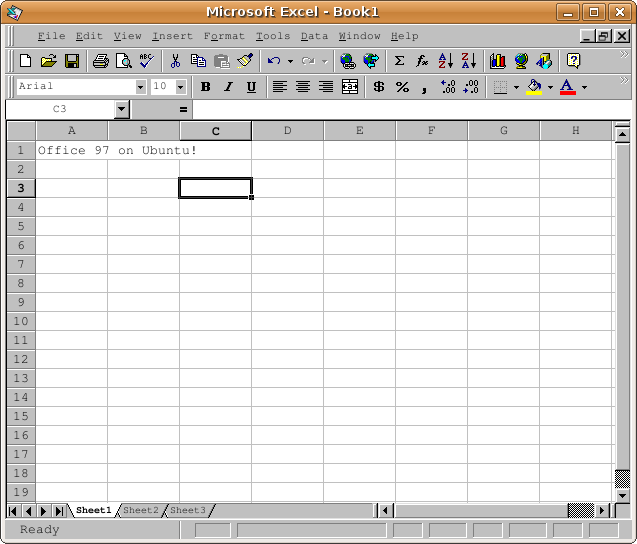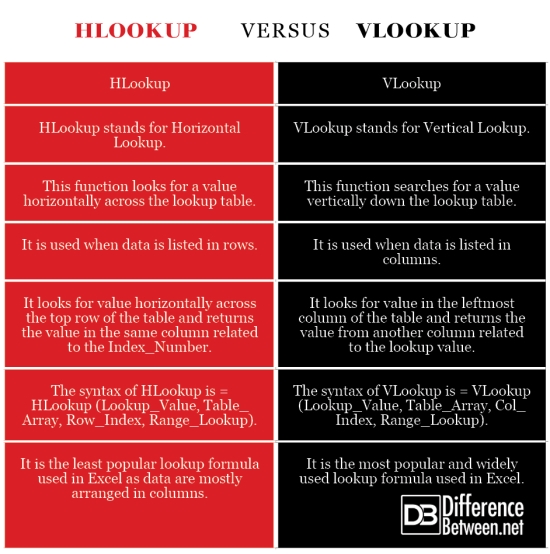Difference Between HLookup and VLookup
In Excel, you often need to look up data in a table which can be hectic at times, especially when it comes to large database tables. Excel is the most widely-used spreadsheet software which not only handles basic data computations but is able to analyze large set of data. Excel uses numerous functions to analyze large sets of data and the two most common functions that most of the modelers are probably familiar with are HLOOKUP and VLOOKUP. Both are the Excel built-in functions that allow you to look up data in a very large database. The “H” in HLookup stands for horizontal, whereas the “V” in VLookup stands for vertical. While both the functions have their fair share of distinguishing points, it’s easy to make a mistake with the functions.
What is Hlookup?
The HLookup function, short for Horizontal Lookup function, is one of the built-in lookup functions in Excel used to find values horizontally across a set of rows in a table. This function is similar to VLookup, except it’s used when data is listed in rows instead of columns. This function searches for a value in the top row of the table and returns a corresponding value from another row of the table. This function uses four arguments: Lookup_Value, Table_Array, Row_Index, and Range_Lookup. It returns a value in a table based on two function arguments and it can take both strings and numbers as arguments. True refers to the approximate match to the lookup value, whereas False refers to the exact match.
What is Vlookup?
The VLookup, or Vertical Lookup, function is the most popular and the oldest lookup formula used in Excel to look for a specific information or data in a spreadsheet. For example, you could search for the price of a specific item from a long list of products along with prices. Unlike the HLookup function, it’s used when data is listed in columns instead of rows and it performs a vertical lookup through the columns in a table. It searches for the value in the leftmost column of the table and returns a value for approximate matches. It can be either TRUE or FALSE.
Difference between HLookup and VLookup
-
Function of HLookup Vs. Vlookup
Both are built-in functions use to look up specific values in a very large data set using Excel lookup formulas. The HLOOKUP, or horizontal lookup, function in Excel is used to perform a horizontal lookup across a set of rows in a spreadsheet. In simple terms, HLOOKUP function searches horizontally through rows to retrieve data from a specific row in the table. The VLOOKUP, or vertical lookup function, on the other hand, is rather used when data is listed in columns instead of rows. It’s similar to the HLOOKUP function, except it performs a vertical lookup through the columns in a spreadsheet.
-
Syntax of HLookup Vs. Vlookup
The syntax of HLookup is = HLookup (Lookup_Value, Table_Array, Row_Index, {Range_Lookup}). The “Lookup_Value” refers to the value the user is trying to look up; “Table_Array” refers to the table or range from which to retrieve data; “Row_Index” refers to the horizontal row where the user is looking to retrieve data; and “Range_Lookup” is an optional Boolean argument that defines the exact match or approximate match to “True” or “False”.
The syntax of VLookup is = VLookup (Lookup_Value, Table_Array, Col_Index, {Range_Lookup}). The “Lookup_Value” refers to the value you’re looking for in a table; “Table_Array” refers to the table or the range of cells from which you’re looking to retrieve data; “Col_Index” refers to the vertical column from which to retrieve data; and finally “Range_Lookup” is an optional argument that determines whether the value is an exact match or an approximate match. The True refers to the approximate match to the lookup value, whereas False refers to the exact match.
-
Process of HLookup Vs. Vlookup
The VLookup function looks for a value vertically in the leftmost column of the table or the data set and returns the adjacent value from another column related to the lookup value. It is used to find the exact match to the lookup value and if an exact match is not found, it can return an approximate match to the lookup value. The HLookup function, on the contrary, looks for a value horizontally in the top row of the table and returns the corresponding value from another row of the table. It’s very similar to VLookup function, except it creates horizontal lookups.
HLookup vs. VLookup: Comparison Chart
Summary of HLookup Vs. VLookup
While both VLookup and HLookup functions are used in Excel to search and retrieve correct values from the lookup table based on the values entered, they are not made equivalent and are suited for specific circumstances. While VLookup is the most popular and the oldest lookup formula in Excel used to perform vertical lookups through the column in a table, the HLookup function is used when data is listed in rows instead of columns and it searches for value horizontally through rows. Each function uses four arguments as pieces of data to locate the data in a very large data set easily and efficiently. As data is mostly arranged in columns, the VLookup function is more frequently used by the modelers as compared to the HLookup function.
- Difference Between Caucus and Primary - June 18, 2024
- Difference Between PPO and POS - May 30, 2024
- Difference Between RFID and NFC - May 28, 2024
Search DifferenceBetween.net :
Leave a Response
References :
[0]Johnson, Steve. Show Me Microsoft Office Excel 2003. Indianapolis: Que Publishing, 2003. Print
[1]Parsons, June, et al. New Perspectives on Microsoft Office Excel 2007. Boston: Cengage Learning, 2007. Print
[2]Besedin, Andrei. Secrets of Lookup: Become More Poductive With Vlookup Free Your Time. Wisconsin: PublishDrive, 2017. Print
[3]Image credit: https://www.flickr.com/photos/psychemedia/10153517664
[4]Image credit: https://www.flickr.com/photos/collinanderson/2050701736



